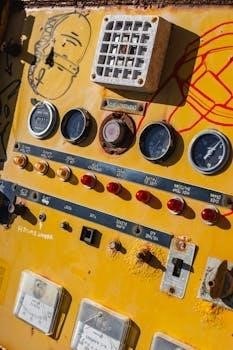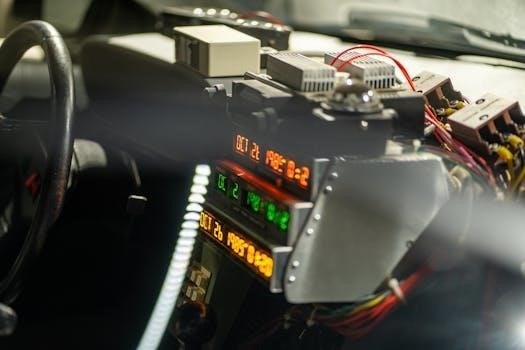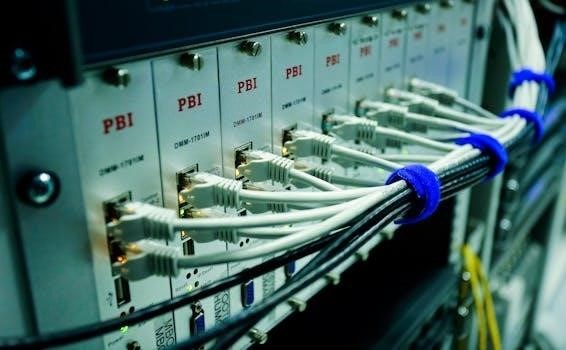4-Way Switch Wiring Diagram PDF⁚ An Overview
This section introduces the 4-way switch and its related wiring diagrams available in PDF format․ These diagrams offer a comprehensive visual aid for understanding the complex wiring involved in multi-location lighting control systems․

Understanding 4-Way Switches
4-way switches enable light control from three or more locations․ They work in conjunction with two 3-way switches․ Understanding their function is crucial before delving into wiring diagrams for successful installation and operation․
Functionality and Purpose of 4-Way Switches
4-way switches serve a specific purpose⁚ to allow control of a light fixture from three or more locations․ Unlike 3-way switches that only facilitate control from two points, 4-way switches act as intermediaries in a circuit between two 3-way switches․ This configuration is beneficial in large rooms or hallways with multiple entry points․
The functionality of a 4-way switch relies on traveler wires․ These wires create different circuit paths, allowing the light to be turned on or off regardless of the position of any of the switches in the circuit․ The internal mechanism of a 4-way switch essentially swaps the connections between these traveler wires․
The primary purpose of a 4-way switch is to enhance convenience․ By strategically placing these switches, users can control lighting from various locations within a space, eliminating the need to traverse the entire area to reach a single switch․ This added control is particularly useful in homes and commercial settings․
Differences Between 3-Way and 4-Way Switches
Understanding the differences between 3-way and 4-way switches is essential for proper wiring․ A 3-way switch allows control of a light fixture from two locations, whereas a 4-way switch enables control from three or more locations․ This fundamental difference stems from their internal mechanisms and wiring configurations;
A 3-way switch has three terminals, including a common terminal and two traveler terminals․ In contrast, a 4-way switch has four traveler terminals and no common terminal․ The 4-way switch is always placed between two 3-way switches in a circuit․ It acts as an intermediary, switching the connections between the traveler wires coming from the 3-way switches․
Wiring a 3-way switch involves connecting the power source to the common terminal of one 3-way switch, running traveler wires between the two 3-way switches, and connecting the light fixture to the common terminal of the other 3-way switch․ A 4-way switch, however, simply intercepts the traveler wires and allows them to be swapped internally, extending the control to another location․
Basic 4-Way Switch Wiring
This section covers the fundamental wiring configurations for integrating a 4-way switch into a lighting circuit․ We’ll explore scenarios, including the placement of the power source․
Wiring Diagram for a Single Light with a 4-Way Switch
Here, we delve into a detailed wiring diagram illustrating how to control a single light fixture using a 4-way switch in conjunction with two 3-way switches․ This configuration allows for controlling the light from three different locations․
The diagram will clearly show the connections between the switches, the light fixture, and the power source․ It emphasizes the crucial role of traveler wires in enabling this multi-location control․ Understanding this diagram is essential for grasping the basic principles behind 4-way switch wiring․
We will cover the two fundamental setups⁚ when power enters the light fixture first and when it enters a 3-way switch first․ The diagram provides a visual representation of the wire connections at the 4-way switch, clarifying the path of electricity․
Power Source Location⁚ Switch vs․ Light Fixture
This section addresses a critical aspect of 4-way switch wiring⁚ the location of the power source․ The wiring configuration differs depending on whether the power source is connected to one of the 3-way switches or directly to the light fixture․
We will explore both scenarios, providing detailed explanations and diagrams for each․ Understanding where the power originates is crucial for correctly wiring the switches and ensuring the circuit functions as intended․ When the power goes to the switch, the wiring configuration is different․
The section will highlight the specific wire connections required in each case, emphasizing the importance of identifying the incoming power wire and connecting it appropriately․ This knowledge is fundamental for safe and effective 4-way switch installation․

Advanced 4-Way Switch Configurations
Delve into complex 4-way switch setups, covering wiring for multiple lights controlled by one set of switches․ Also explains how to add additional 4-way switches for control from even more locations․
Multiple Lights and 4-Way Switch Wiring
Wiring multiple lights with a 4-way switch setup involves extending the basic wiring principles to accommodate additional fixtures․ This configuration is useful in larger rooms or hallways where several lights need to be controlled from three or more locations; The key is to maintain the continuity of the traveler wires and the common connections throughout the circuit․
The wiring becomes slightly more complex as you need to ensure that each light fixture receives both the neutral and the switched hot wire․ One common method is to connect all the lights in parallel, so each receives the full voltage․ This requires careful planning and wiring to avoid overloading the circuit․
Always consult local electrical codes and consider consulting with a qualified electrician for safety and compliance․
Adding Additional 4-Way Switches
Expanding the control of a lighting circuit to more than three locations requires the addition of extra 4-way switches between the two 3-way switches․ Each additional 4-way switch allows for another control point, offering enhanced convenience in large spaces with multiple entrances․
The wiring for this configuration involves connecting the traveler wires from one 4-way switch to the next, effectively extending the circuit․ The 3-way switches remain at the ends of the circuit, acting as the entry and exit points for the power flow․ It’s crucial to maintain consistent wiring patterns to prevent short circuits or malfunctions․
When adding multiple 4-way switches, ensure that all connections are secure and properly insulated․ Accurate wiring diagrams are essential to avoid confusion and ensure the circuit functions as intended․ Always prioritize safety and consult with a qualified electrician if needed․
Wiring Diagrams and Schematics
This section highlights the importance of wiring diagrams and schematics for 4-way switch installations․ These visual aids are essential for accurate wiring and troubleshooting of complex electrical circuits․
Importance of Accurate Wiring Diagrams
Accurate wiring diagrams are crucial for the successful and safe installation of 4-way switches․ These diagrams serve as a roadmap, guiding electricians and DIY enthusiasts through the intricate network of wires and connections required for multi-location lighting control․ Without a clear and precise diagram, the risk of miswiring increases significantly, potentially leading to electrical malfunctions, short circuits, or even fire hazards․
A well-detailed wiring diagram eliminates guesswork and provides a visual representation of the circuit’s components and their interconnections․ This visual clarity is especially important in 4-way switch configurations, where the complexity of the wiring can be daunting․ By following an accurate diagram, users can ensure that all wires are connected correctly, minimizing the chances of errors and ensuring the system operates as intended․
Furthermore, accurate diagrams are invaluable for troubleshooting existing 4-way switch installations․ When problems arise, a reliable diagram allows for systematic identification and correction of wiring issues․ This saves time and effort, preventing unnecessary damage to electrical components․
PDF Resources for 4-Way Switch Wiring
Numerous PDF resources are available online, offering detailed wiring diagrams and schematics for various 4-way switch configurations․ These PDF documents provide a convenient and accessible way to learn about and implement 4-way switch wiring․ Many websites offer free downloads of these diagrams, catering to both novice and experienced electricians․
These PDF resources often include step-by-step instructions, color-coded wiring diagrams, and troubleshooting tips․ Some even provide interactive elements or animations to further enhance understanding․ When selecting a PDF resource, it’s important to verify the accuracy and reliability of the information․ Look for diagrams from reputable sources, such as electrical supply companies, professional electricians, or established DIY websites․
Furthermore, consider the specific configuration you’re working with․ Different wiring scenarios, such as power entering the light fixture first or multiple lights controlled by a single switch, may require different diagrams․ Ensure that the PDF resource you choose matches your specific needs․ These resources often include information on grounding, wire identification, and safety precautions․

Safety and Best Practices
Safety is paramount when working with electrical wiring․ This section outlines critical safety measures, including proper grounding techniques and wire identification, to prevent accidents during 4-way switch installations․
Grounding and Wire Identification
Proper grounding is crucial for electrical safety․ Always connect the green or bare copper wire to the grounding screw on the switch and in the electrical box․ Incorrect grounding can lead to electrical shock or fire hazards․ Wire identification is also essential for correct wiring․
Typically, black wires are hot, white wires are neutral, and red wires can be hot or used as travelers in switch circuits․ In 4-way switch configurations, traveler wires connect between the switches, allowing control from multiple locations․ Tag wires during the installation of any switch․ This is very important when wiring․
Accurate wire identification prevents short circuits and ensures the circuit functions as intended․ Use a multimeter to verify wire functions if unsure and always de-energize the circuit before handling any wires, ensuring a safe working environment․
Safety Precautions Before Wiring
Before commencing any electrical work, prioritizing safety is critical․ The first and foremost precaution is to disconnect the power supply to the circuit at the breaker panel․ This eliminates the risk of electrical shock during the wiring process․ Double-check that the power is off using a non-contact voltage tester․
Wear appropriate safety gear, including insulated gloves and eye protection, to guard against potential hazards․ Avoid working in damp or wet conditions, as water increases the risk of electrocution․ Ensure that your tools are properly insulated and in good working order․
If you are not comfortable working with electricity or lack experience, consult a qualified electrician․ Electrical work can be dangerous, and mistakes can have serious consequences․ Taking these precautions ensures a safer working environment․

Troubleshooting 4-Way Switch Wiring
This section addresses common issues encountered during 4-way switch wiring․ It provides solutions for diagnosing and resolving problems, ensuring proper functionality of the multi-location lighting control system․
Common Wiring Issues and Solutions
Troubleshooting 4-way switch wiring can be complex, but identifying common issues is key to a swift resolution․ One frequent problem is incorrect traveler wire connections, leading to lights not switching correctly from all locations․ Swapping the traveler wires on a 4-way switch can often resolve this․ Another issue arises from misidentified common terminals on 3-way switches; ensure these are properly connected to the power source and light fixture․ A multimeter is invaluable for testing wire continuity and voltage․
Loose wire connections are also a common culprit․ Ensure all connections are tight and secure․ Incorrectly grounded switches can cause erratic behavior or safety hazards․ Verify proper grounding for all switches․ Furthermore, misinterpreting wiring diagrams can lead to errors․ Always double-check the diagram and wire connections․ If issues persist, consult a qualified electrician to avoid potential electrical hazards․ Remember safety first!